Altice Labs ME4624-ONTRGW Wireless Optical Network Termination (ONT)

About Altice Labs
Delivering key telecommunications technologies since 1950, Altice Labs has been shaping the future of technology, enabling Communications Service Providers and Enterprises to offer advanced and differentiated services to their customers and users.
Altice Labs is an innovation and transformation catalyst supported by a strong and dynamic Innovation Ecosystem. Through technology, we are committed to improving people’s lives and how companies do business.
Overview
The ONT-RGW is an Optical Terminal Equipment (ONT) unit for Passive Optical Networks (PON) termination in an FTTH (Fiber-To-The-Home) service delivery architecture. ONT-RGW communicates with the OLT (Optical Line Terminal) for the PON side and with the customer’s premises for the client side. This equipment supports triple-play services – high-speed internet (HSI), voice (VoIP), video (IPTV and RF Overlay), and WPS (WiFi Protected Setup). The use of the GPON fiber access technology does allow a significant service delivery increase when compared with traditional xDSL technologies.
The ONT-RGW equipment technology is based on GEM (GPON Encapsulation Method), and complies with ITU-T
G.984.x. recommendation as like G.984.4 (OMCI) ensuring interoperability with major GPON OLT vendors
(BBF.247).
These base functionalities, together with the support for bit rates of up to 2.5 Gbps (downstream) and 1.24 Gbps
(upstream), an optical network splitting ratio of up to 1:64 in a single fiber and a distance range of up to 60 km, makes the GPON technology and the ONT-RGW the most efficient option for passive optical network topologies when integrated service delivery is an issue.
Together with multi-vendor OLT interoperability (BBF.247 certified), other differentiated features of the ONT-RGW product are the embedded RF Video Overlay as well as the chance to have several TV channel packs by means of using remote-managed analog RF video overlay filters. The use of an embedded optical reflective component also increases probing resolution in the case of FTTH probing.
The ONT-RGW is also one of the first single-household integrated CPE solutions (ONT+GATEWAY).
As opposed to the point-to-point architecture, in which there is one physical port per client in the Central Office, in GPON point-to-multipoint architecture there is only a single laser and photo-detector in the Central Office (CO) to serve up to 64 CPEs. All the Optical Distribution Network is built by means of passive equipment modules with a long-live MTBF standard and very low OPEX.
ONT-RGW MAIN FUNCTIONALITIES
The ONT is aimed at customer premises and complies with the ITU-T G.984.x recommendation in order to transport (over GPON) and deliver (to the premises domain) the full pack of broadband services.
Broadband service applications are commonly referred to as below:
- High-speed internet (HSI);
- Voice (VoIP) services (SIP/MEGACO H.248);
- TV (whether IPTV or analog RF video overlay);
- WiFi.
The multiplay environment is thus reinforced when combining the upper referred services.
APPLICATION SCENARIO
The next figure shows possible gateway scenarios for ONT-RGW equipment when in an end-to-end PON architecture.
ONT-RGW applications scenario
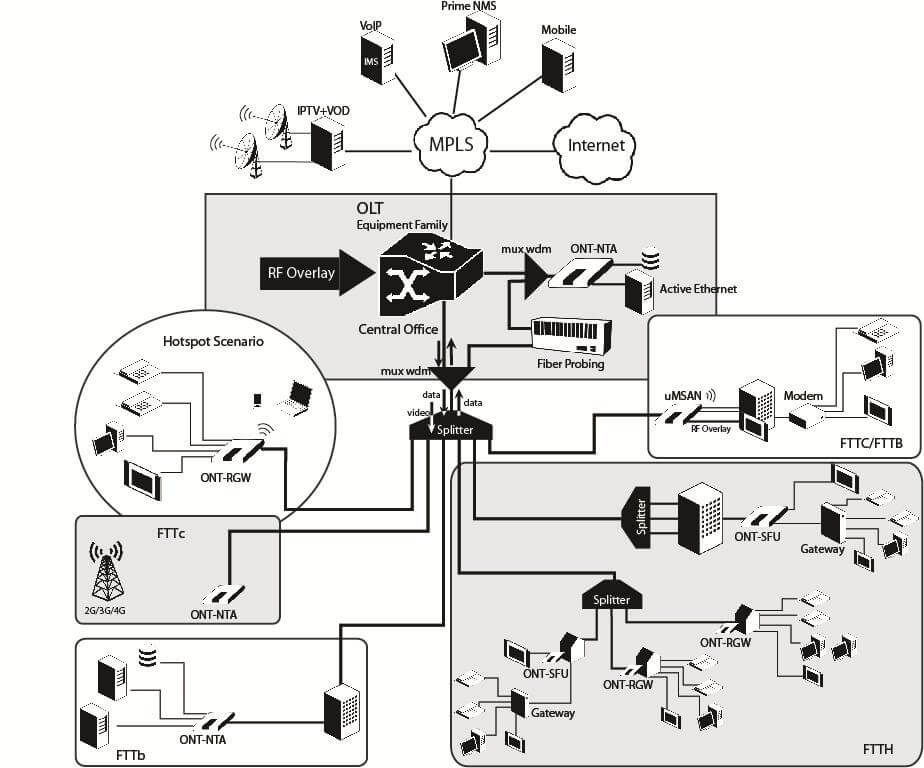
INTEROPERABILITY
The ONT gateway equipment complies with ITU-T G.984.x. recommendation as like as G.984.4 (OMCI) ensuring multi-vendor OLT interoperability with major GPON OLT vendors, as defined in BBF.247 ONU certification program.
BBF.247 ONU certification program certifies ONT link layer configuration and management protocol, OMCI, Figure 2, as defined by ITU-T G.984.3, ITU-T G.984.4, and ITU-T G.988.
Link Layer Configuration and Management
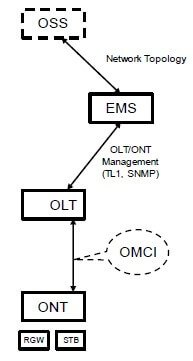
IP-based services configuration and management is achieved by means of the TR-069 protocol as defined by Broadband Forum. This procedure takes for granted that previously the link layer connectivity has been achieved.
TR-069 is then transparent to the OLT since the TR-069 connections are established between the ACS and the ONTs,
ONT gateway equipment integrates gateway functionalities. Link layer configuration and management are achieved by the use of OMCI, while IP-based services (RG functionality and Voice over IP) are configured and managed by TR-069,
ONT gateway equipment configuration
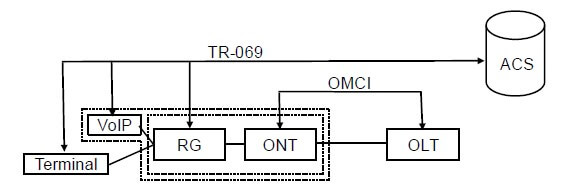
IP Based services-TR069 configuration
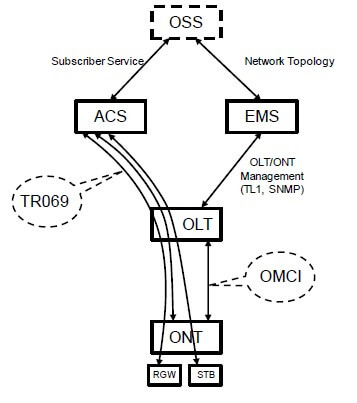
INTERFACES
Client interface options are of types:
- 4x 100/1000Base-T for Ethernet network connection (RJ45 connectors);
- 2x FXS channels (RJ11 connectors);
- 2×2 @ 2.4/5.0 GHz wireless interfaces (802.11 b/g/n);
- 2x USB 2.0 Masters for printer sharing, media sharing, and 3G/4G backup uplink;
- RF Overlay interface;
- Control switches for power and WiFi;
The network interface option is of type: GPON SC/APC Optical connector (B+/C+).
GENERAL FEATURES
GPON is a point-to-multipoint passive optical network, in which unpowered optical splitters are used to enable a single optical fiber to serve multiple premises, typically 1-64.
A PON consists of an optical line terminal (OLT) at the central office and a number of optical network terminals (ONT) at the customer premises. Downstream signals are broadcasted to all premises sharing multiple fibers. Encryption can prevent eavesdropping. Upstream signals are combined using a multiple access protocol (Time Division Multiple Access – TDMA). The OLT queues data to the various ONT terminals in order to provide time slot assignments for upstream communication. it is shown a scenario for a multi-service user domain basic architecture through an ISP network.
Optical fiber Internet service user access
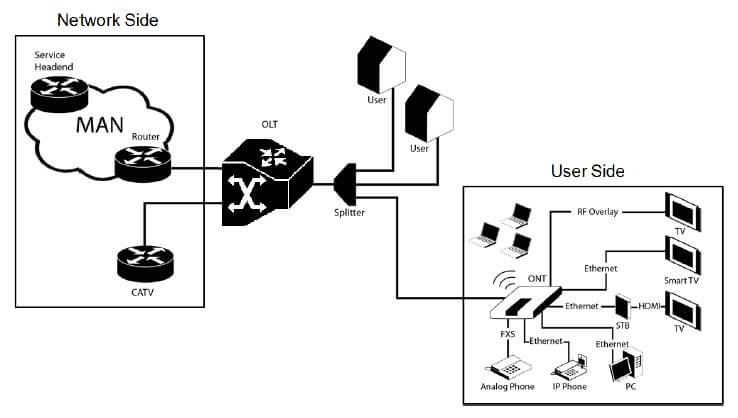
In the upstream direction, the ONT-RGW is connected to the optical splitter and respectively to the OLT through the PON port to provide integrated access services through the service headend.
In the downstream direction, the ONT-RGW is connected to various terminals through the following LAN-side ports to implement multi-play services:
- Four 10/100/1000M Base-T Ethernet ports, which can be connected to terminals such as PCs, STBs, and video phones to provide high-speed data and video services;
- Two FXS ports, which can be connected to telephone sets to provide VoIP services;
- Two Wi-Fi antennas, which can connect to Wi-Fi terminals wirelessly to provide a secure and reliable high-speed wireless network;
- Two USB ports, which can be connected to a USB storage device to provide convenient storage and file-sharing services within a home network;
- One RF Overlay port, which can be connected to a TV set to provide high-quality CATV service.
The communication between client equipment (ONT) and the ISP access routers (MAN edge) is made by an optical fiber-based passive architecture (ITU-T G.984 Recommendation). The GPON network acts as a Layer 2 Ethernet metropolitan network. Access network assures and controls the media (MAC) communication through a TDMA scheme, introducing GEM (GPON Encapsulation Method) in between to adapt the TDM layer to Ethernet.
Operational description
The ONT-RGW supports WIFI, with a WIFI interface currently operating at a 2.4GHz frequency.
The ONT-RGW complies with the following standards:
- IEEE 802.11b (2.4GHz, 11 to 22 Mbps)
- IEEE 802.11g (2.4Ghz, up 54 Mbps)
- IEEE 802.11n (MIMO-OFDM 2.4GHz, 65Mbps to 300Mbps)
The ONT supports the following wireless security features:
- WEP encryption (64/128 bits)
- WPA (Wireless Protect Access) TKIP
- WPA2 AES
- 4WPA2 mixed
- 802.1x Authentication
- Client access control through media access control (MAC) filter
- Dynamic cryptography (TKIP and AES)
GENERAL SPECIFICATIONS
The ONT-RGW GPON G.984.x layer uses 1490nm downstream and 1310nm upstream optical wavelengths, with 2,488Gbps downstream and 1,244Gbps upstream by using an SC/APC protected optical connector.
|
Items |
Unit |
B+ |
C+ |
|
ONT Tx |
ONT Tx |
||
|
Nominal bit rate |
Mbps |
1244.16 |
1244.16 |
|
Operating wavelength |
nm |
1260-1360 |
1260-1360 |
|
Line code |
— |
Scrambled NRZ |
Scrambled NRZ |
|
Minimum ORL of ODN |
dB |
>32 |
>32 |
|
Mean launched power MIN |
dBm |
+0.5 |
+0.5 |
|
Mean launched power MAX |
dBm |
+5 |
+5 |
|
Launched optical power without input to the Tx |
dBm |
Less than Min sensitivity -10 |
Less than Min sensitivity -10 |
|
Maximum Tx Enable |
|
16 |
16 |
|
Maximum Tx Disable |
|
16 |
16 |
|
Extinction ratio |
dB |
>8.2 |
>8.2 |
|
Tolerance to the Tx incident light power |
dB |
>-15 |
>-15 |
|
SLM Laser – MAX −20 dB width |
nm |
1 |
1 |
|
SLM Laser – MIN SMSR |
dB |
30 |
30 |
|
|
|
ONT Rx |
ONT Rx |
|
Receiving bit rate |
Mbps |
2488.32 |
2488.32 |
|
Receiving wavelength |
nm |
1480-1500 |
1480-1500 |
|
Max reflectance of equipment, measured at Rx wavelength |
dB |
<-20 |
<-20 |
|
Bit error ratio |
— |
<-10-10 |
<-10-10 |
|
Minimum sensitivity |
dBm |
-27 |
-30* |
|
Minimum overload |
dBm |
-8 |
-8* |
|
Upstream optical penalty |
dB |
0.5 |
0.5 |
|
Consecutive identical digit immunity |
bit |
>72 |
>72 |
|
Tolerance to reflected optical power |
dB |
<10 |
<10 |
|
|
|
ONT Rx Video |
|
|
Receiving wavelength |
nm |
1550-1560 |
|
|
* ONT RX= -8~-30 dBm (The ONT sensitivity assumes the use of the optional RS (255,239) FEC capability of the G-PON TC layer with the current class B+ ONU detector technology; The ONU overload is set at –8 dBm to be common with the class B+ value, even though in this application –10 dBm is sufficient). Optical solution: B+ and C+. Connector type: SC/APC. IEC 60825-1: “Class 1 Laser Product”. The B+ and C+ triplexer is embedded on the ONT equipment version. ONU Single Fiber – G.984.2 (03/2003) + G.984.2 Amd 1 (02/2006) and 2 (03/2008), G.983.3 (03/2001). |
|||
ETHERNET
Ethernet is the wired LAN technology and is revised in the IEEE 802.3 standard. At the OSI reference system, Ethernet is at the Data Link layer. In the ONT-RGW equipment, the LAN type of physical interface is 10/100/1000BASE-T AUTO-MIX Ethernet type over RJ45 connectors.
RF OVERLAY
Broadcast video signal travels over fiber from the CO in the 1550nm wavelength and is demuxed and converted in the ONT-RGW to an F connector (75 Ohm) RF Overlay interface to deliver an RF TV signal going from 47MHz up to 1GHz of bandwidth.
FXS Interface specifications
|
Items |
State |
Description |
|
Pulse Dialing |
Pulse Frequency: 10 Hz (8 Hz to 12 Hz) Pulse Relation: 66,6% (33% to 75%) Interdigital Pause and Pre- Dialing: 400 ms (min) |
– |
|
DTMF |
– |
According to ETSI CTR 21 [1] |
|
Clip |
– |
According to ETSI 300 659-1 |
|
Clip on Call Waiting |
– |
According to ETSI 300 659-2 |
|
DC voltage (V) |
-48V (-46 to -54) |
– |
|
Loop Current Characteristics (A) |
20mA (min) to 60mA (max) |
– |
|
Ifeed Max. (A) |
45mA |
– |
INTERFACES
|
Items |
State |
Description |
|
|
Impedance and Transmission Requirements (Ω) |
Q.552 [4] (11/96) of ITU-T 220Ω+820Ω//115nF. |
A telephone that comply with transmission requirements defined in CTR 38, should comply with SLR, RLR and STMR (4.2.2.1, 4.2.2.2 and 4.2.3) standard requisites, when connected to a FXS interface. |
|
|
ILA (A) |
20 – 45 mA |
5 bit parameter which sets the current limit for DC feed (DC feed and battery switch are programmed and calibrated to ILA=26mA, VOC=48V, VAS=3V, bshv=5V). |
|
|
Ringer voltage (V) |
DC offset: 48V AC voltage: 75Vrms +/- 0.5% Frequency: 25Hz +/- 3% |
– |
|
|
Ringing signal |
normal ringing |
1 sec ring / 5 sec pause (interval = 6 sec). |
|
|
Hook flash |
on-hook – register recall/hook flash |
100 msec |
Minimum time of recognition of “on- hook” when hook-flash feature does not exist |
|
on-hook – register recall/hook flash |
1000 msec |
Minimum time “on-hook” recognition when hook-flash feature does exist |
|
|
off-hook |
40 msec |
minimum time “off-hook” recognition |
|
|
interval |
160msec – 400msec |
Time calibrated break pulse duration for register recall recognition |
|
NOTE:
FXS interface-specific parameter values vary according to country-adopted standards. ONT-RGW FXS interface specifications table values are configurable at the web management interface at the menu Voice, item SIP basic settings, by selecting the local(Country) where the ONT-RGW will be used. Please refer to section SIP BASIC SETTING, for details on this configuration.
WIFI specification
|
Items |
Compliance |
Description |
|
|
IEEE 802.11 b/g/n |
– |
|
Bit Rates |
802.11 b/g |
1, 2, 5.5, 6, 9, 11, 12, 18, 24, 36, 48 and 54Mb/s |
|
802.11 n |
Up to 300Mb/s over two spatial streams |
|
|
SSID |
– |
Up to 8 |
|
Operation Frequencies |
– |
2.4GHz (ISM) or 5GHz (U-NII) |
|
Channels |
– |
20MHz and 40MHz channels |
|
MIMO |
– |
2×2 |
|
MCS |
– |
supported values: 0-15 and 32 |
|
Wireless Security |
WEP |
40bit secure key and 24 bit as defined in 802.11-2007 |
|
Items |
Compliance |
Description |
|
|
WPA |
|
|
WPA2 |
|
|
|
AES |
encryption/de-encryption coupled to TKIP (as defined in 802.11-2007 and 802.1X) |
|
|
Short Guard Interval |
SGI support |
– |
|
Space-Time Block Coding |
STBC support |
– |
|
Transmit Power |
– |
Up to +18dBm |
|
Receive Sensitivity |
Mode b (8% PER) |
1Mb/s: -96dBm 11Mb/s: -88dBm |
|
Mode g (10% PER) |
6Mb/s: -90dBm 12Mb/s: -89dBm 54Mb/s: -75dBm |
|
|
Mode n/2.4GHz (10% PER) |
1Mb/s: -96dBm 54Mb/s: -75dBm M0/20MHz: -86 dBm M0/40MHz: -83 dBm M15/20MHz: -69 dBm M15/40MHz: -69 dBm |
|
|
Mode n/5GHz (10% PER) |
6Mb/s: -89 dBm 54Mb/s: -74 dBm M0/20MHz: -85 dBm M0/40MHz: -82 dBm M15/20MHz: -68 dBm M15/40MHz: -68 dBm |
GENERAL FEATURES
|
Features |
ONT-RGW |
|
GPON |
1x Singlemode Optical Fiber Cable (SC/APC Connector) |
|
Ethernet 10/100/1000Base-T |
4x Ethernet UTP CAT5E direct or crossover AUTO-MDIX cable (RJ45) |
|
RF Video Overlay (1) |
1x Coaxial F type connector (75 Ohm) |
|
RF Video Overlay Analog Filter Pack |
Yes (Option of Up to 3 Analog Filters) |
|
FXS Ports |
2x voice / fax RJ11 connector |
|
USB Ports |
2x USB 2.0 |
|
WiFi (802.11b/g/n) |
Yes |
|
ON/OFF button |
Yes |
|
RESET button |
Yes |
|
OLT Interoperability (BBF.247) |
Yes |
|
DHCP Client |
Yes |
|
Number of GEM ports |
256 |
|
Number of T-CONT |
32 |
|
Primary Power Connection (VDC) |
12 (± 15%) |
|
Primary Power Connection (VAC) |
230V AC 50Hz ±2Hz / 110V AC 60Hz ±2Hz |
|
Power Supply (W) (2) |
19 |
|
MTBF (h) |
404660 |
|
Size (mm) |
210x210x40 |
|
Temperature (⁰ C) |
-5 to 45 |
|
Humidity (%) |
0 to 95 |
NOTES:
- Optional. Dependent on the ONT-RGW-specific model
- An LPS power source is used to power the ONT equipment:
- US/Canada: The ONT must be powered by an external Listed Limited Power Source (LPS) or Class 2 Power source. The external power adapter must be LPS certified.
- Rest of the World: The ONT must be powered by an External CB-approved Limited Power Source (LPS).
GENERAL SERVICE DESCRIPTION
|
GPON layer per G984.x |
> Comply with GPON standard: ITU-T G984.1/G984.2/G984.3/G984.4; > GPON Encapsulation Method (GEM) supports Ethernet; > Configurable AES Downstream and FEC Downstream and Upstream; > Bitrates: 2488 Gbps (downstream) / 1244 Gbps (upstream). |
> Class B+ optics (28 dB); > T-CONT:32; > GEM-Port-IDs: 32. |
|
L2/L3 layer |
> VLAN-ID to GEM port-ID mapping (per WT- 156): N:1 VLAN; 1:1; > Transparent VLAN; > Classification: IDSCP/TOS, 802.1p TCI, VLAN ID, MAC address; > Traffic Management: up to 8 queues per T- CONT in Priority-controlled mode or up to 16 queues per T-CONT in Rate-controlled scheduling mode. |
> 802.1q VLAN processing: Q-in-Q, tagging, removing tag, replacing tag or transparent forwarding; > Routing: Network Access Translation (NAT) and Network Access Port Translation (NAPT); > Firewall; > VPN; > DHCP Client and Server; > PPPoE Client; > Performance: 1000 Mbps Bidirectional. |
|
IPTV |
> IGMP v1/v2/v3 snooping; > IGMP processing per VLAN ID to support group of channels; > Interactive services (Video On Demand); > IPTV streams forwarding simultaneous: 128; > IPTV prioritization using Quality of Service (QoS) using 802.1p. |
– |
|
VoIP |
> T.38 Fax Relay; > Fax/Data Bypass; > Echo Canceller; > Echo Canceller Length; > Jitter Buffer; > Caller ID Generation; > G.711 PLC; > G.711 VAD and CNG; > G.723.1; > G.726 ADPCM; > G.729 Annex A. |
> G.729 Annex B; > Caller ID and Call waiting; > RTP/RTCP packet encapsulation; > RFC 2833 support; > In-band Signaling Detection and Generation (dial, busy, ring-back, stutter, distinctive ring); > 3-Way Conferencing; > RFC 3261 support (SIP). |
|
Ethernet |
> RJ-45 10/100/1000BASE-T; > Support Auto-negotiation; > Support auto MDI/MDIX. |
– |
|
Video Overlay (1) |
> One port on a F Connector; > 75 Ohm impedance (nominal). |
> TV overlay: 1550nm -8dBm < Pin < +2dBm; > Analog bandwidth: minimum 47 MHz and maximum 1000 MHz; > Channel number depends on PAL B/G, PAL M, etc, systems. |
|
WiFi |
> IEEE 802.11 b/g/n |
> 802.11 b/g: 1, 2, 5.5, 6, 9, 11, 12, 18, 24, 36, 48 and 54Mb/s; > 802.11 n: Up to 300Mb/s over 2 spatial streams. |
|
Management |
> Web-based with GUI; > Remote management over the OMCI, PLOAM, OAM and TR-069, TR-104, TR-111, TR-142. |
> Secure software download upgrade via OMCI or TR-069; > Embedded Telnet server for remote management. |
FCC/IC NOTICE
This device complies with FCC Part 15 FCC Rules.
Operation is subject to the following two conditions:
- This device may not cause harmful interference and
- This device must accept any interference, including interference that may cause undesired operation of the device
Caution:
Changes or modifications not expressly approved by the party responsible for compliance could void the user’s authority to operate the equipment.
Note: This equipment has been tested and found to comply with the limits for a Class B digital device, pursuant to part 15 of the FCC Rules. These limits are designed to provide reasonable protection against harmful interference in a residential installation. This equipment generates, uses, and can radiate radio frequency energy and, if not installed and used in accordance with the instructions, may cause harmful interference to radio communications. However, there is no guarantee that interference will not occur in a particular installation. If this equipment does cause harmful interference to radio or television reception, which can be determined by turning the equipment off and on, the user is encouraged to try to correct the interference by one or more of the following measures:
- Reorient or relocate the receiving antenna.
- Increase the separation between the equipment and the receiver.
- Connect the equipment to an outlet on a circuit different from that to which the receiver is connected.
- Consult the dealer or an experienced radio/TV technician for help.
FAQS About Altice Labs ME4624-ONTRGW Wireless Optical Network Termination
Q: What is the Altice Labs ME4624-ONTRGW?
A: The Altice Labs ME4624-ONTRGW is a Wireless Optical Network Termination (ONT) device developed by Altice Labs. It is designed to provide high-speed fiber-optic connectivity to end-users in a wireless manner.
Q: What wireless technologies does the Altice Labs ME4624-ONTRGW support?
A: The ME4624-ONTRGW supports multiple wireless technologies, including Wi-Fi and LTE. It allows users to connect their devices wirelessly to the internet and enjoy high-speed connectivity without the need for physical cables.
Q: Can I use the Altice Labs ME4624-ONTRGW with any internet service provider (ISP)?
A: The ME4624-ONTRGW is typically deployed by service providers who utilize Altice Labs’ infrastructure and services. It is specifically designed to work within Altice Labs’ network environment. Therefore, it is recommended to consult with your ISP or Altice Labs directly to confirm compatibility and availability.
Q: What is the range of the wireless connectivity provided by the Altice Labs ME4624-ONTRGW?
A: The wireless range of the ME4624-ONTRGW can vary depending on factors such as the specific wireless technology used (e.g., Wi-Fi), the environmental conditions, and any potential signal interference. It is generally designed to provide coverage within a typical residential or small office environment.
Q: Can the Altice Labs ME4624-ONTRGW support multiple users simultaneously?
A: Yes, the ME4624-ONTRGW is designed to support multiple users simultaneously. It is built to handle the demands of a residential or small office environment where multiple devices may be connected and accessing the internet at the same time.
Q: Does the Altice Labs ME4624-ONTRGW have any additional ports or interfaces?
A: While the specific details may vary depending on the model and configuration, the ME4624-ONTRGW typically includes additional ports and interfaces. These can include Ethernet ports for wired connections, voice ports for telephony services, and potentially other interfaces for specific applications or services.
Q: Is the Altice Labs ME4624-ONTRGW compatible with other Altice Labs devices and solutions?
A: The Altice Labs ME4624-ONTRGW is typically designed to integrate seamlessly with other Altice Labs devices and solutions within the service provider’s network ecosystem. However, compatibility and integration may depend on the specific configuration and compatibility guidelines provided by Altice Labs.
For more manuals, visit Manualsdock


